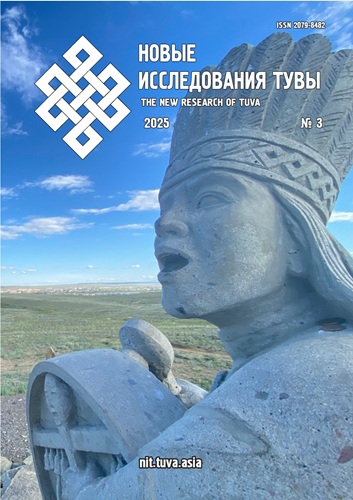Analysis of Emotion Frequency in the Texts of Kazakh and Tuvan Literature
DOI:
https://doi.org/10.25178/nit.2025.3.6Keywords:
Tuvan literature; Kazakh literature; novella; emotional vocabulary; emotional word; comparative analysisAbstract
The article presents a comparative content-contextual analysis of emotional expressions in two literary works — the novella “A Childhood That Never Happened” by Kazakh writer Akberen Elgizhek and the novella “The Story of the Bright Boy” by Tuvan writer Stepan Saryg-ool, both examined in their Russian-language literary translations.
The study is based on a corpus analysis of the texts, which enables the identification of the frequency of key emotions (“fear”, “sadness”, “joy”, “sorrow”, and “anger”) and their contextual meanings. In the Tuvan novella, there is a predominance of the lexemes “fear” and “sadness”, indicating an open and explicit mode of emotional representation. In contrast, in the Kazakh novella, emotions such as “joy”, “fear”, and “sorrow” are more often conveyed implicitly, through context and artistic imagery.
The findings of the study demonstrate that emotional vocabulary in Tuvan prose tends to express feelings in a more direct and explicit manner, while in Kazakh prose, emotions are more frequently communicated through poetic imagery and contextual nuances. This distinction is rooted in national storytelling traditions and cultural conventions of emotional perception.
References
Altybayeva, S. M. (2011) Modern Kazakh Prose: Analysis, Interpretation, Comprehension. Almaty, “Ulagat” Abai Kazakh National Pedagogical University. 127 p. (In Russ.)
Grebnev, L.V. (1957) On the Popular Nature of the Tuvan Heroic Epos. Uchyonye zapiski, vol. V. Ed. by N. A. Serdobov. Kyzyl, Tuvan Scientific Research Institute of Language, Literature and History. Pp. 159–177. (In Russ.)
Imanalieva, G. K. (2011) Emotional Structures in the Kazakh Language. Almaty, Kazakh University. 255 p. (In Russ.)
Lamazhaa, Ch. K. (2018) The National Character of the Tuvans. Moscow; St. Petersburg, Nestor-History. 240 p. (In Russ.)
Salchak, A. Ya., Akhmatova, M. A. and Chertykova, M. D. (2022) Means of Expressing the Emotion of Fear in Turkic Languages. New Research of Tuva, no. 2, pp. 224–238. (In Russ.) DOI: https://doi.org/10.25178/nit.2022.2.16
Silman, T. L. (1977) Notes on Lyrics. Leningrad, Leningrad Branch of the Publishing House “Soviet Writer”. 224 p. (In Russ.)
Temirbolat, A. B. (2023) Features of the Development of Kazakh Prose in the Period of Independence. Keruen, vol. 78, no. 1, pp. 24–37. (In Russ.) DOI: https://doi.org/10.53871/2078-8134.2023.1-02
Toqsambayeva, A. O. (2022) Artistic Features of Contemporary Kazakh Prose. Vestnik Evraziiskogo gumanitarnogo instituta, no. 3, pp. 188–196. (In Russ.) DOI: https://doi.org/10.55808/1999-4214.2022-3.18
Tsybenova, Ch. S. (2020) Means of Expressing Emotivity in the Tuvan Language (Based on Diminutives). Bulletin of Udmurt University. Series History and Philology, vol. 30, no. 5, pp. 813–819. (In Russ.) DOI: https://doi.org/10.35634/2412-9534-2020-30-5-813-819
Shakhovsky, V. I. (2008) Linguistic Theory of Emotions. Moscow, Gnosis. 416 p. (In Russ.)
Cowen, A. S. and Keltner, D. (2017) Self-report captures 27 distinct categories of emotion bridged by continuous gradients. Proceedings of the National Academy of Sciences, vol. 114, issue 38, pp. E7900–E7909. DOI: https://doi.org/10.1073/pnas.1702247114
Damasio, A. and Carvalho, G. B. (2013) The Nature of Feelings: Evolutionary and Neurobiological Origins. Nature Reviews Neuroscience, vol. 14, issue 12, pp. 143–152. DOI: https://doi.org/10.1038/nrn3403
Ledoux, J. E., Brown, R. (2017) A Higher-Order Theory of Emotional Consciousness. Proceedings of the National Academy of Sciences, vol. 114, issue 10, pp. E2016–E2025. DOI: https://doi.org/10.1073/pnas.1619316114
Plutchik, R. (2005) Emotions and Life: Perspectives from Psychology, Biology, and Evolution. American Psychological Association, vol. 162, issue 2, pp. 409–410. DOI: https://doi.org/10.1176/appi.ajp.162.2.409
Pugh, Z. H., Choo, S., Leshin, J. C., Lindquist, K. A., and Nam, C. S. (2022) Emotion depends on context, culture and their interaction: Evidence from effective connectivity. Social Cognitive and Affective Neuroscience, vol. 17, issue 2, pp. 206–217. DOI: https://doi.org/10.1093/scan/nsab092
Published
How to Cite
For citation:
Mansurova E. Zh., Orda G. Zh. and Askarova G. S. Analysis of Emotion Frequency in the Texts of Kazakh and Tuvan Literature. New Research of Tuva, 2025, no. 3, pp. 82-93. (In Russ.). DOI: https://doi.org/10.25178/nit.2025.3.6
Issue
Section

This work is licensed under a Creative Commons Attribution-NonCommercial 4.0 International License.

Author(s) license holder(s) grant rights for their work to the journal (grantee of a license) under the simple non-exclusive open license in accordance with Art. 1286.1 «Open license for a research work, work of literature or fine arts», Civil Code of the Russian Federation.
New Research of Tuva publishes articles under the Creative Commons Attribution-NonCommercial license (CC BY-NC).
Since it is an open license, author(s) reserve the right to upload the article to their institutional repository, submit it to another journal (if it allows republications), or republish it on their own website (in full, or in part).
However, several conditions apply here:
a) The republished version must always contain the name(s) and affiliation(s) of the author(s), the original title and the hyperlink to the original version on the New Research of Tuva website;
b) It must be in open access, free of charge, and no category of readers must be in any way whatsoever advantaged over general readership.
c) should the contribution be submitted elsewhere by its author(s) without substantial modification (30% or more of original text unchanged), the body of the article should contain a disclaimer that the original version was published in New Research of Tuva (with a link to the respective page)
The CC-BY-NC is a non-revocable license which applies worldwide and lasts for the duration of the work’s copyright.











